
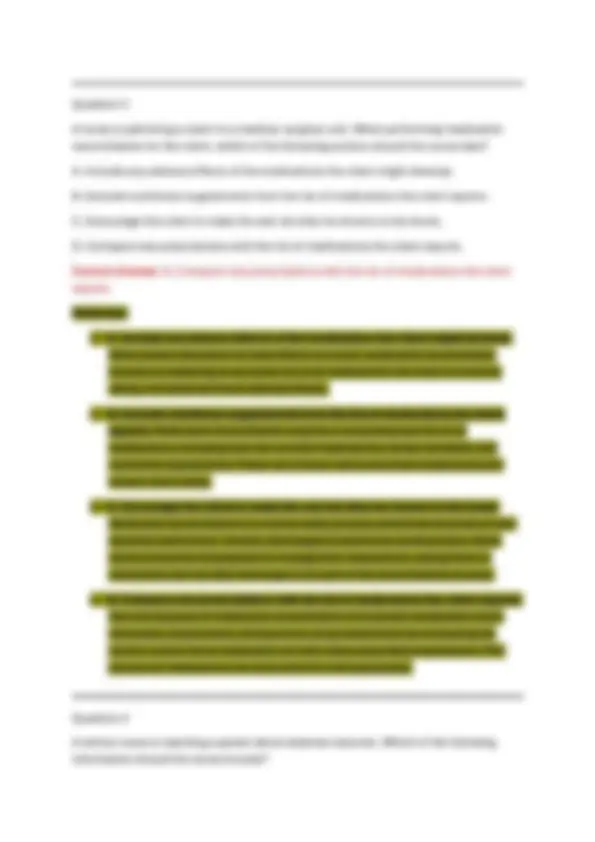
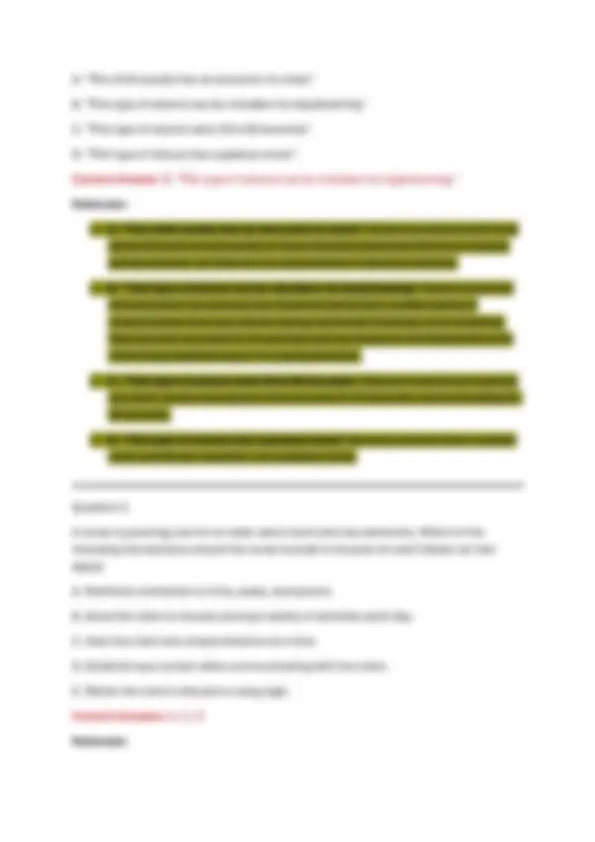
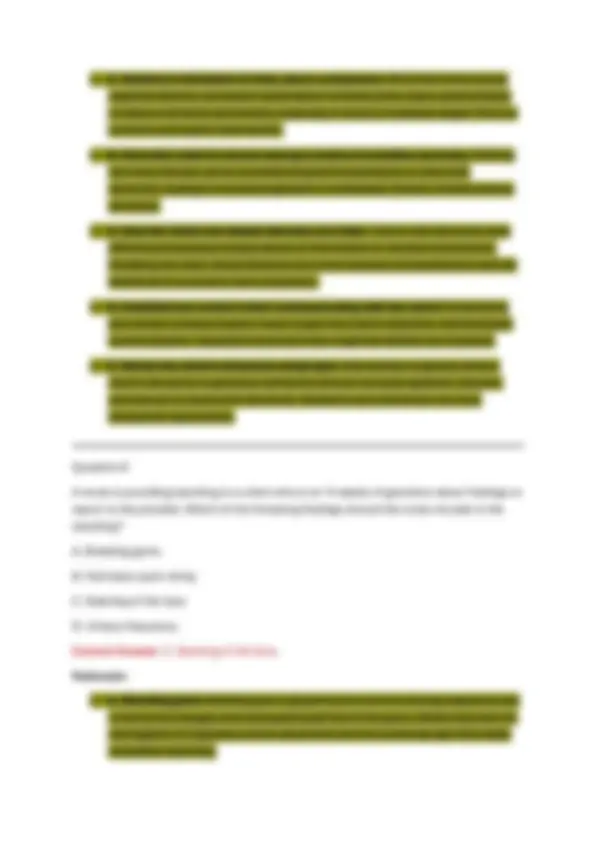
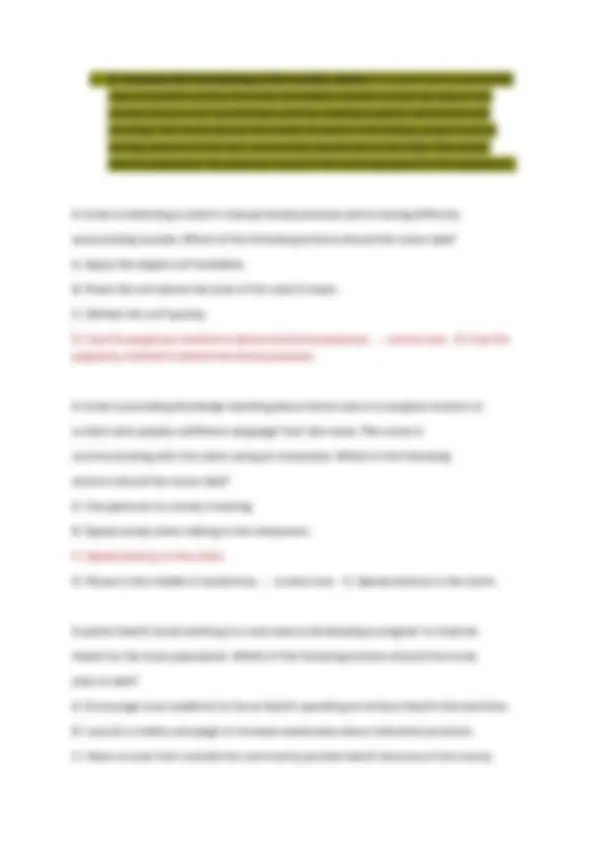
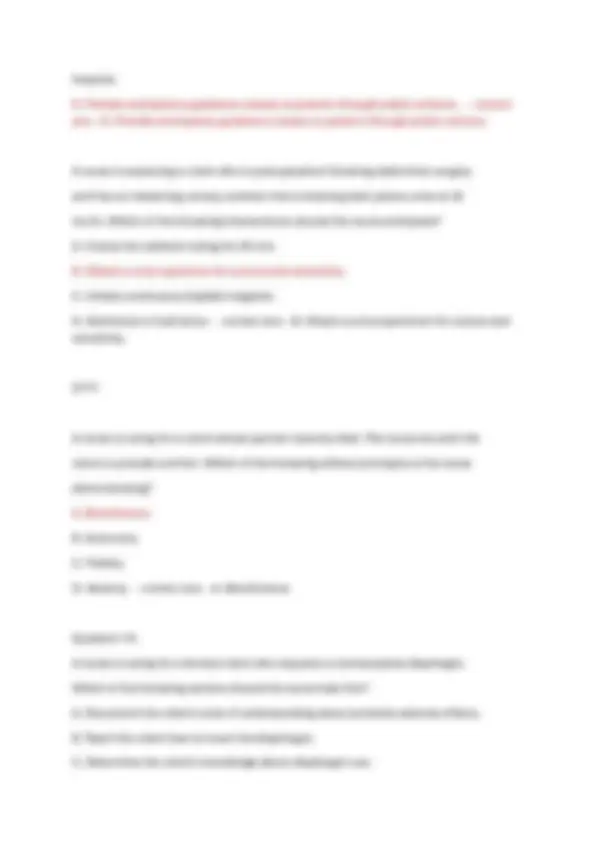
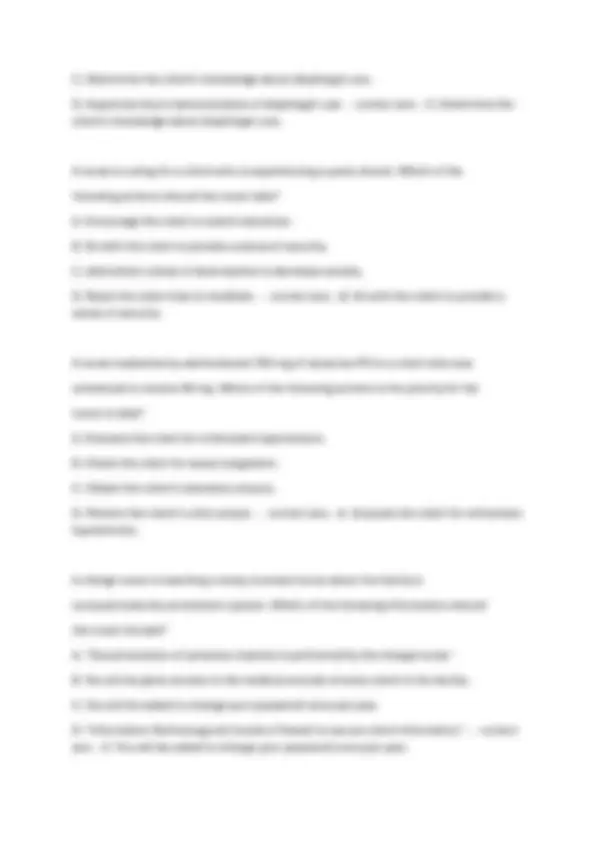
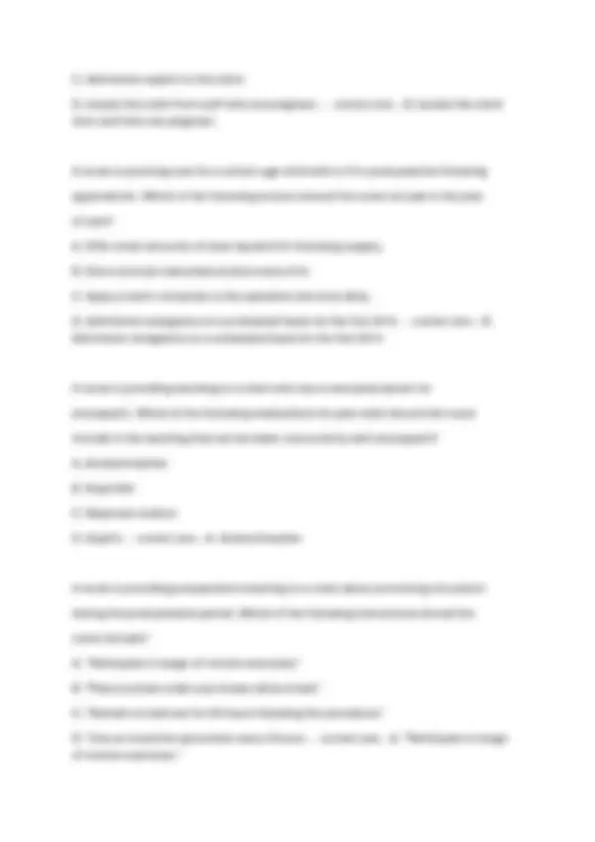
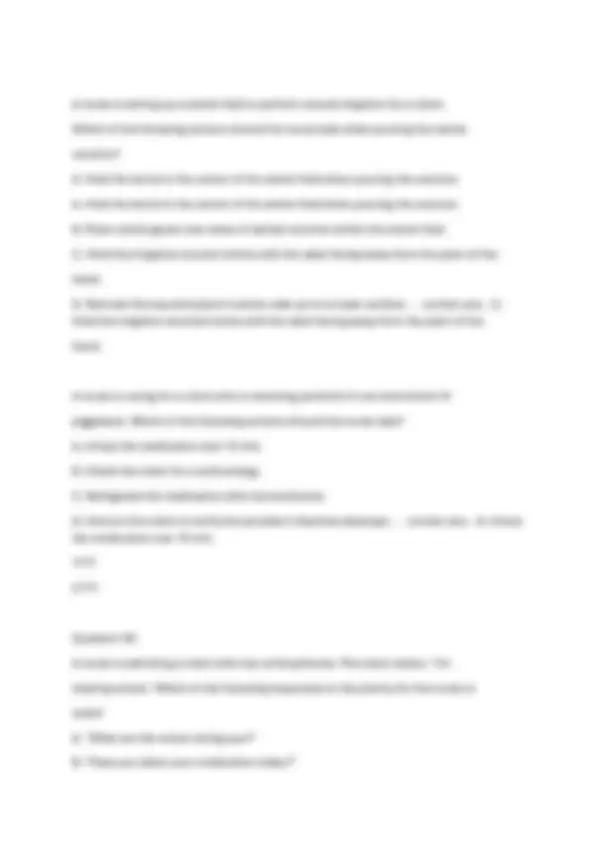

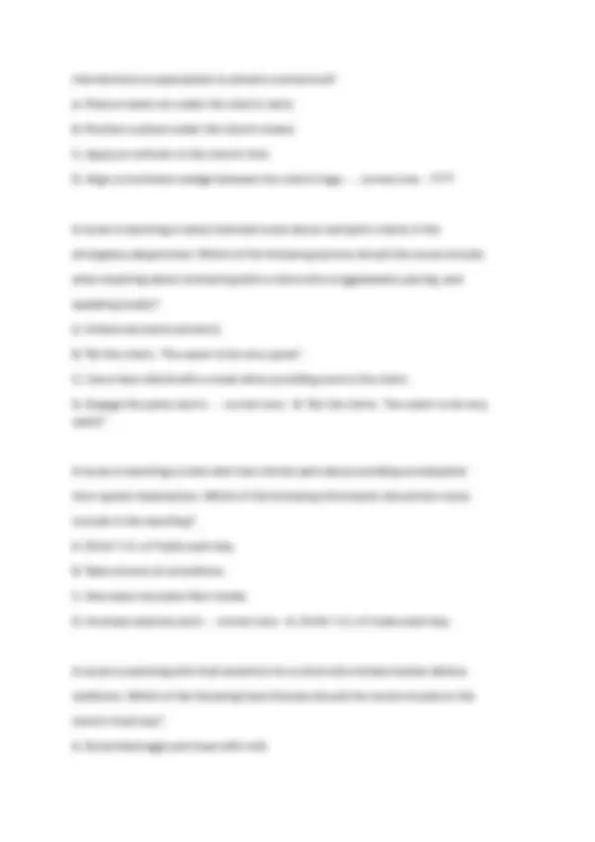
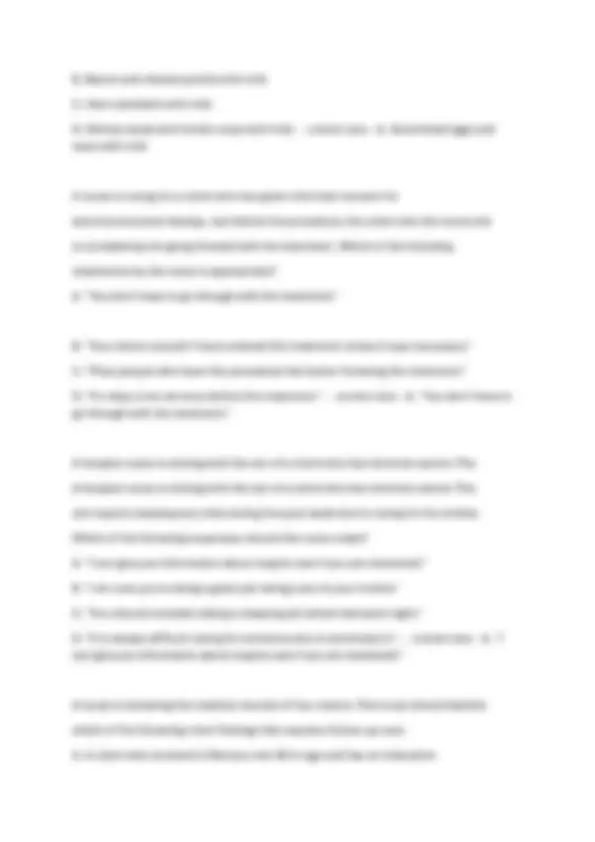
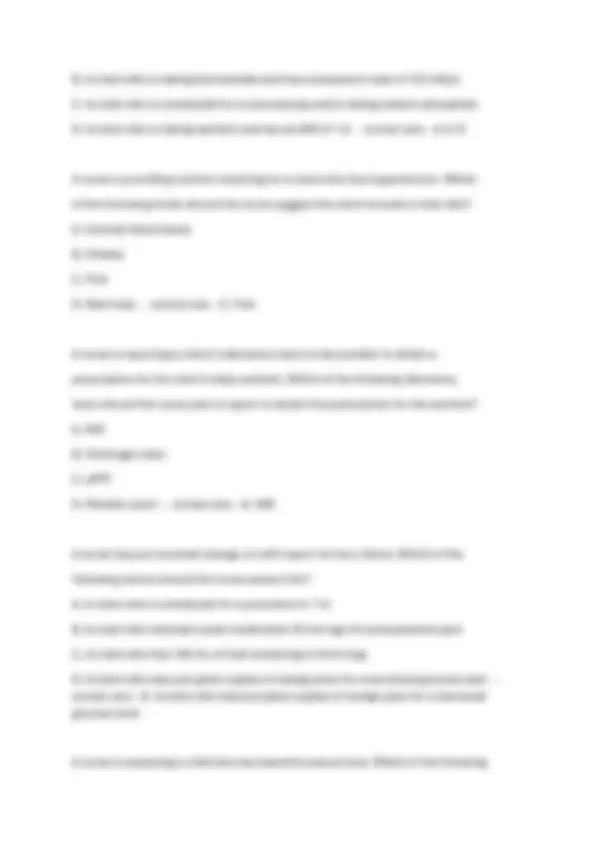
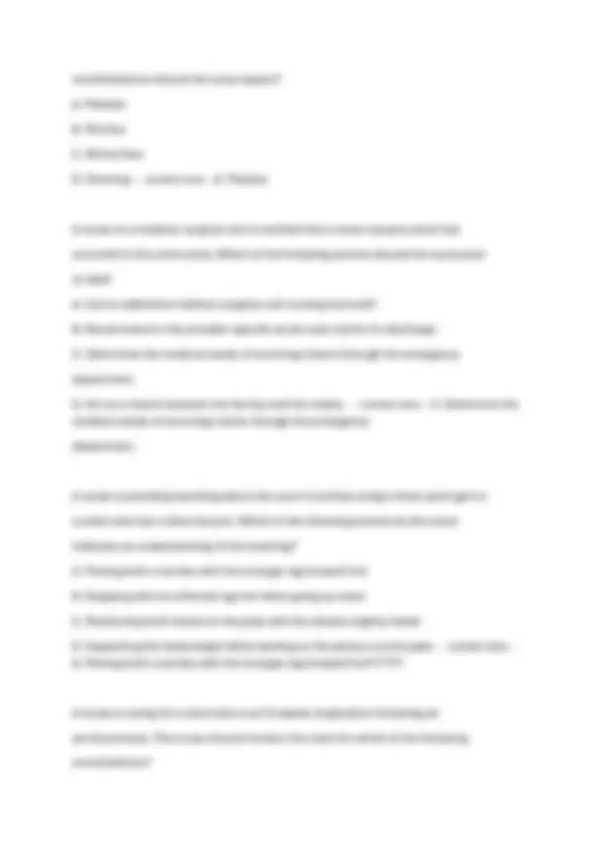
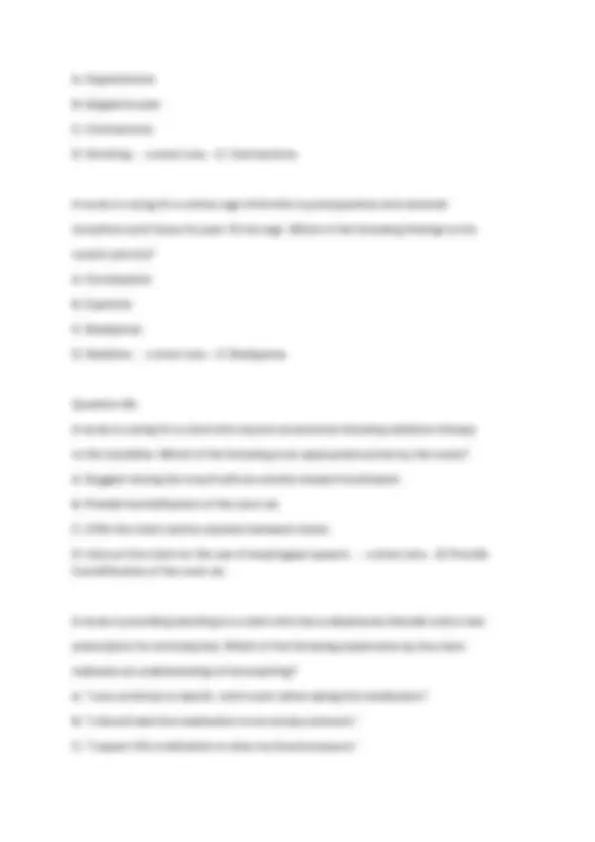
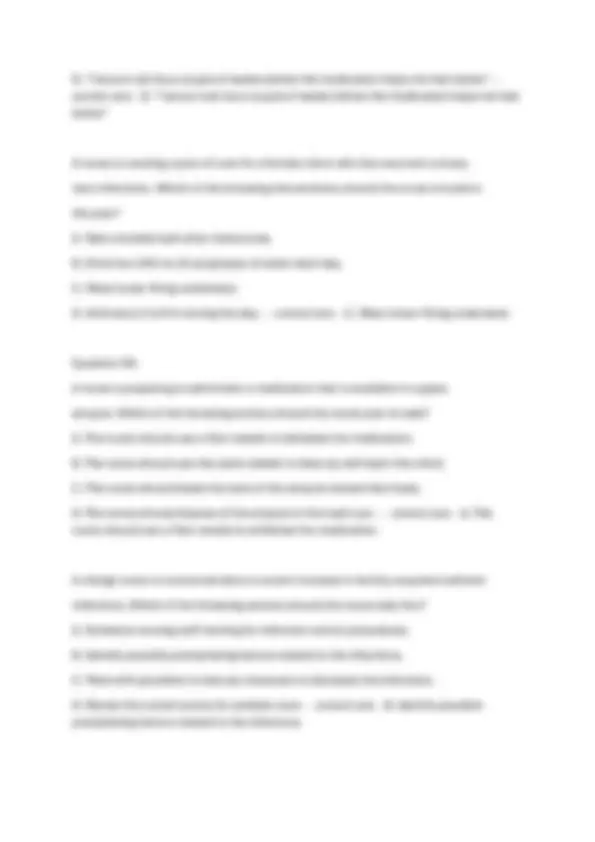
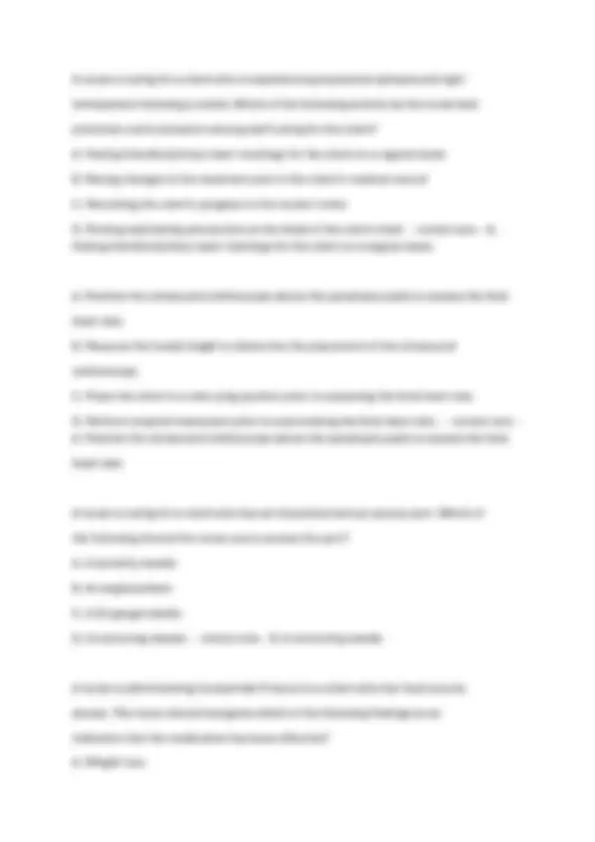
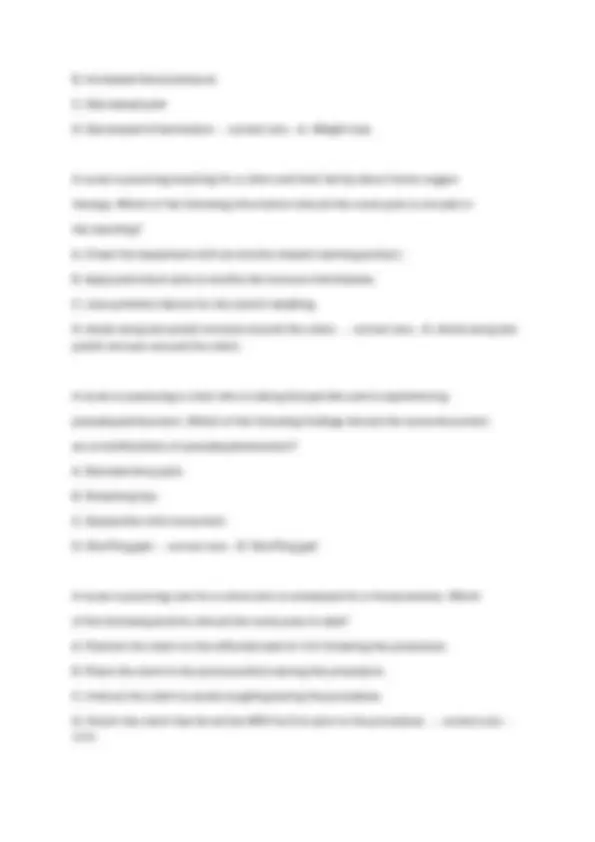
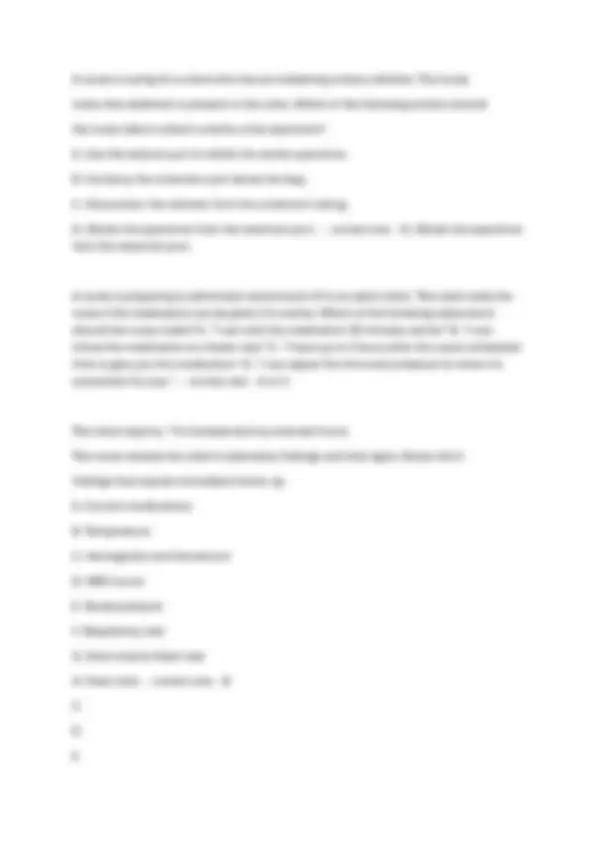
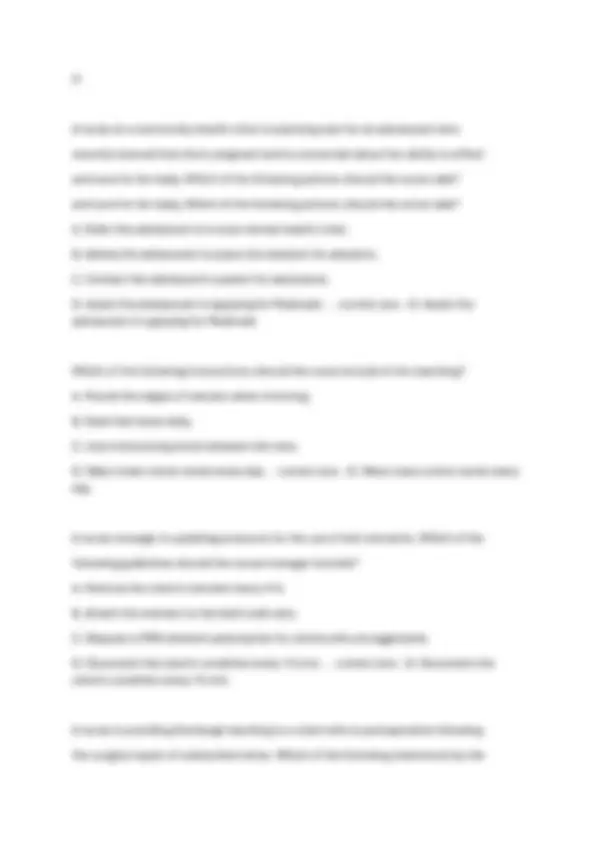
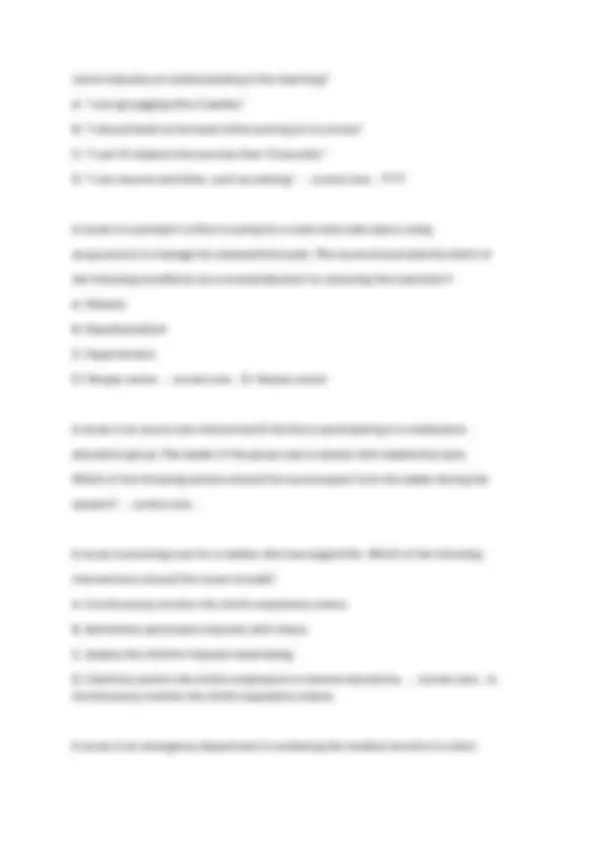
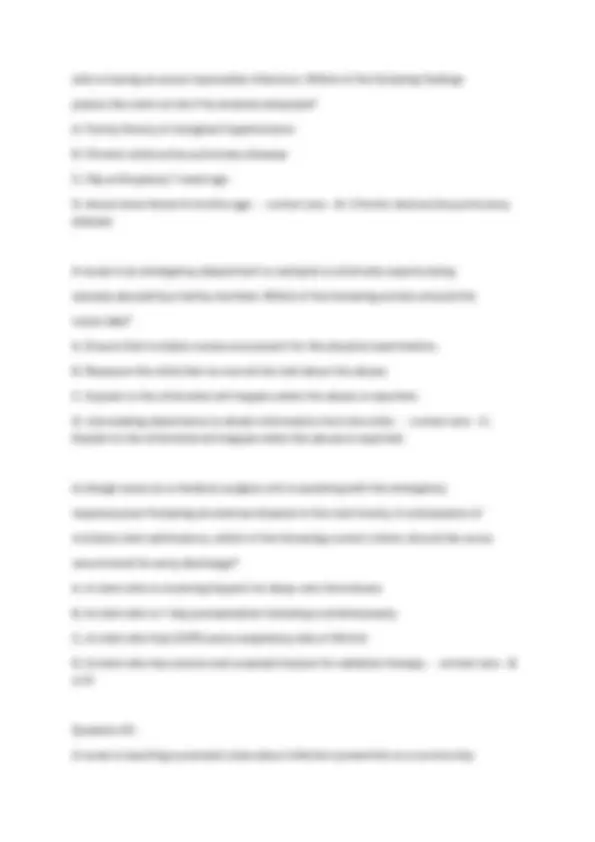
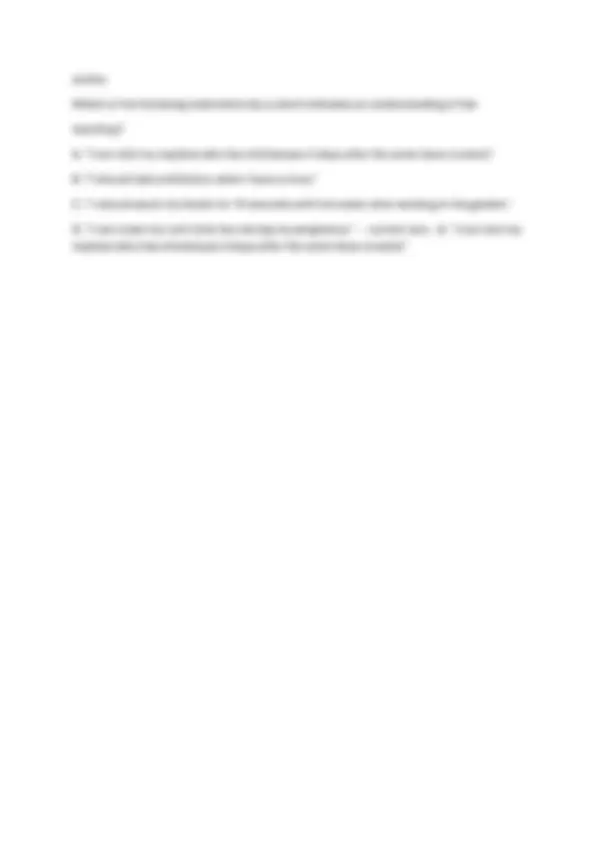


Study with the several resources on Docsity

Earn points by helping other students or get them with a premium plan


Prepare for your exams
Study with the several resources on Docsity

Earn points to download
Earn points by helping other students or get them with a premium plan
Community
Ask the community for help and clear up your study doubts
Discover the best universities in your country according to Docsity users
Free resources
Download our free guides on studying techniques, anxiety management strategies, and thesis advice from Docsity tutors
A.T.I RN Comprehensive Predictor 2025 Exam Prep: Full-Length Practice Tests, Detailed Answer Rationales, and Expert Strategies to Pass Your Final Nursing Exam with Confidence
Typology: Exams
1 / 30

This page cannot be seen from the preview
Don't miss anything!























Here are the multi-choice questions with rationales and indicated correct answers for the provided list. Question 1 A nurse is caring for a child who has cystic fibrosis and requires postural drainage. Which of the following actions should the nurse take? A. Perform the procedure twice each day. B. Hold the hand flat to perform percussions on the child. C. Administer a bronchodilator after the procedure. D. Perform the procedure prior to meals. Correct Answer: D. Perform the procedure prior to meals. Rationale:
A. "The child usually has an aura prior to onset." B. "This type of seizure can be mistaken for daydreaming." C. "This type of seizure lasts 30 to 60 seconds." D. "This type of seizure has a gradual onset." Correct Answer: B. "This type of seizure can be mistaken for daydreaming." Rationale:
C. Determine the client's knowledge about diaphragm use. D. Supervise return demonstration of diaphragm use - - correct ans- - C. Determine the client's knowledge about diaphragm use. A nurse is caring for a client who is experiencing a panic attack. Which of the following actions should the nurse take? A. Encourage the client to watch television. B. Sit with the client to provide a sense of security. C. Administer a dose of atomoxetine to decrease anxiety. D. Teach the client how to meditate. - - correct ans- - B. Sit with the client to provide a sense of security. A nurse inadvertently administered 160 mg of valsartan PO to a client who was scheduled to receive 80 mg. Which of the following actions is the priority for the nurse to take? A. Evaluate the client for orthostatic hypotension. B. Check the client for nasal congestion. C. Obtain the client's laboratory results. D. Monitor the client's urine output. - - correct ans- - A. Evaluate the client for orthostatic hypotension. A charge nurse is teaching a newly licensed nurse about the facility's computerized documentation system. Which of the following information should the nurse include? A. "Documentation of sensitive material is performed by the charge nurse." B. You will be given access to the medical records of every client in the facility. C. You will be asked to change your password once per year. D. "Information Technology will install a firewall to secure client information." - - correct ans- - C. You will be asked to change your password once per year.
Question 18: A home health nurse is caring for a child who has Lyme disease. Which of the following is an appropriate action for the nurse to take? A. Educate the family to avoid sharing personal belongings. B. Ensure the state health department has been notified. C. Administer antitoxin. D. Assess for skin necrosis - - correct ans- - A. Educate the family to avoid sharing personal belongings. A nurse is caring for a client who has experienced a stroke and is moving in with their adult child. Which of the following actions should the nurse encourage the client and family to take as they adjust to their new roles? A. Minimize open discussion regarding the changes to avoid embarrassment. B. Decrease socialization with extended relatives until roles are identified. C. Encourage authoritative communication from the adult child. D. Implement firm but flexible boundaries in their relationship - - correct ans- - D. Implement firm but flexible boundaries in their relationship A nurse is planning care for a client who has a prescription for a bowel-training program following a spinal cord injury. Which of the following actions should the nurse include in the plan of care? A. Administer a cathartic suppository 30 min prior to scheduled defecation times. B. Encourage a maximum fluid intake of 1,500 mL per day. C. Increase the amount of refined grains in the client's diet. D. Provide the client with a cold drink prior to defecation. - - correct ans- - A. Administer a cathartic suppository 30 min prior to scheduled defecation times. A nurse is caring for a client who has acute glomerulonephritis. Which of the
C. Administer aspirin to the client. D. Isolate the client from staff who are pregnant. - - correct ans- - D. Isolate the client from staff who are pregnant. A nurse is planning care for a school-age child who is 4 hr postoperative following appendicitis. Which of the following actions should the nurse include in the plan of care? A. Offer small amounts of clear liquids 6 hr following surgery. B. Give cromolyn nebulized solution every 8 hr. C. Apply a warm compress to the operative site once daily. D. Administer analgesics on a scheduled basis for the first 24 hr - - correct ans- - D. Administer analgesics on a scheduled basis for the first 24 hr A nurse is providing teaching to a client who has a new prescription for enoxaparin. Which of the following medications for pain relief should the nurse include in the teaching that can be taken concurrently with enoxaparin? A. Acetaminophen B. Ibuprofen C. Naproxen sodium D. Aspirin - - correct ans- - A. Acetaminophen A nurse is providing preoperative teaching to a client about promoting circulation during the postoperative period. Which of the following instructions should the nurse include? A. "Participate in range-of-motion exercises." B. "Place a pillow under your knees while in bed." C. "Remain on bed rest for 24 hours following the procedure." D. "Use an incentive spirometer every 4 hours - - correct ans- - A. "Participate in range- of-motion exercises."
A nurse is setting up a sterile field to perform wound irrigation for a client. Which of the following actions should the nurse take when pouring the sterile solution? A. Hold the bottle in the center of the sterile field when pouring the solution. A. Hold the bottle in the center of the sterile field when pouring the solution. B. Place sterile gauze over areas of spilled solution within the sterile field. C. Hold the irrigation solution bottle with the label facing away from the palm of the hand. D. Remove the cap and place it sterile-side up on a clean surface. - - correct ans- - C. Hold the irrigation solution bottle with the label facing away from the palm of the hand. A nurse is caring for a client who is receiving penicillin G via intermittent IV piggyback. Which of the following actions should the nurse take? A. Infuse the medication over 10 min. B. Check the client for a sulfa allergy. C. Refrigerate the medication after reconstitution. D. Instruct the client to notify the provider if diarrhea develops. - - correct ans- - A. Infuse the medication over 10 min. ???? C??? Question 30: A nurse is admitting a client who has schizophrenia. The client states, "I'm hearing voices." Which of the following responses is the priority for the nurse to state? A. "What are the voices telling you?" B. "Have you taken your medication today?"
A nurse is providing teaching to a client about the adverse effects of sertraline. Which of the following adverse effects should the nurse include? A. Metallic taste in the mouth B. Excessive sweating C. Increased urinary frequency D. Dry cough - - correct ans- - B. Excessive sweating A nurse in a long-term care facility is providing care for a client who has been receiving donepezil. Which of the following findings indicates that the medication is effective? A. Improved short-term memory B. Increased food intake C. Can perform ADLs independently D. Enhanced mood - - correct ans- - A. Improved short-term memory A nurse is planning to teach a client about taking prednisone. Which of the following instructions should the nurse include? A. Take on an empty stomach. B. Schedule dosage at bedtime. C. Increase dietary calcium. D. Monitor for weight loss. - - correct ans- - D. Monitor for weight loss. A nurse is caring for a client who is receiving intermittent enteral tube feedings. Which of the following factors places the client at risk for aspiration? A. A residual of 65 mL 1 hr postprandial B. Sitting in high-Fowler's position during the feeding C. A history of gastroesophageal reflux disease
D. Receiving a high-osmolarity formula - - correct ans- - A. A residual of 65 mL 1 hr postprandial A nurse is planning care for a client who has a prescription for continuous enteral feedings through an NG tube. Which of the following actions should the nurse plan to take? A. Measure gastric residual volumes every 4 hr. B. Flush the NG tube with 30 mL 0.9% sodium chloride before and after medication. C. Maintain the head of the bed at a 20° angle. D. Advance the rate of the feeding every 2 hr. - - correct ans- - B. Flush the NG tube with 30 mL 0.9% sodium chloride before and after medication. Question 39: A nurse is caring for a 2-year-old toddler. Which of the following food choices should the nurse recommend to promote independence in eating? A. Banana slices B. Hot dog C. Grapes D. Popcorn - - correct ans- - A. Banana slices A nurse is caring for an infant who has gastroenteritis. Which of the following assessment findings should the nurse report to the provider? A. Pale and a 24-hr fluid deficit of 30 mL B. Sunken fontanels and dry mucous membranes C. Temperature 38°C (100.4°F) and pulse rate 124/min D. Decreased appetite and irritability - - correct ans- - B. Sunken fontanels and dry mucous membranes A nurse is caring for a client who is immobile. Which of the following
B. Bacon and cheese quiche with milk C. Ham sandwich with milk D. Shrimp salad and tomato soup with milk - - correct ans- - A. Scrambled eggs and toast with milk A nurse is caring for a client who has given informed consent for electroconvulsive therapy. Just before the procedure, the client tells the nurse she is considering not going forward with the treatment. Which of the following statements by the nurse is appropriate? A. "You don't have to go through with the treatment." B. "Your doctor wouldn't have ordered this treatment unless it was necessary." C. "Most people who have this procedure feel better following the treatment." D. "It's okay to be nervous before this treatment." - - correct ans- - A. "You don't have to go through with the treatment." A hospice nurse is visiting with the son of a client who has terminal cancer. The A hospice nurse is visiting with the son of a client who has terminal cancer. The son reports sleeping very little during the past week due to caring for his mother. Which of the following responses should the nurse make? A. "I can give you information about respite care if you are interested." B. "I am sure you're doing a great job taking care of your mother." C. "You should consider taking a sleeping pill before bed each night." D. "It is always difficult caring for someone who is terminally ill." - - correct ans- - A. "I can give you information about respite care if you are interested." A nurse is reviewing the medical records of four clients. The nurse should identify which of the following client findings that requires follow-up care. A. A client who received a Mantoux test 48 hr ago and has an induration
B. A client who is taking bumetanide and has a potassium level of 3.6 mEq/L C. A client who is scheduled for a colonoscopy and is taking sodium phosphate D. A client who is taking warfarin and has an INR of 1.8 - - correct ans- - A or D A nurse is providing nutrition teaching for a client who has hypertension. Which of the following foods should the nurse suggest the client include in their diet? A. Canned black beans B. Cheese C. Fish D. Red meat - - correct ans- - C. Fish A nurse is reporting a client's laboratory tests to the provider to obtain a prescription for the client's daily warfarin. Which of the following laboratory tests should the nurse plan to report to obtain the prescription for the warfarin? A. INR B. Fibrinogen level C. aPTT D. Platelet count - - correct ans- - A. INR A nurse has just received change-of-shift report for four clients. Which of the following clients should the nurse assess first? A. A client who is scheduled for a procedure in 1 hr B. A client who received a pain medication 30 min ago for postoperative pain C. A client who has 100 mL of fluid remaining in his IV bag D. A client who was just given a glass of orange juice for a low blood glucose level - - correct ans- - D. A client who was just given a glass of orange juice for a low blood glucose level A nurse is assessing a child who has bacterial pneumonia. Which of the following